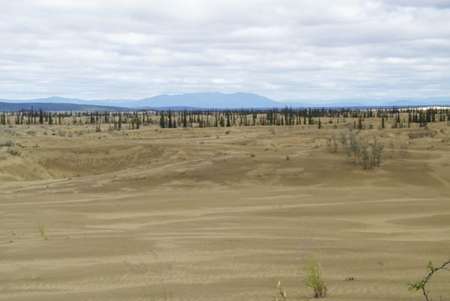Study finds liquid water flowing above and below frozen Alaskan sand dunes, hints of a wetter Mars

(Phys.org) —The presence of liquid water at and beneath frozen Alaskan sand dunes during Arctic winter suggests that liquid water could also be temporarily stable (or metastable) at frost-covered sand dunes on Mars.
A team of earth and planetary scientists from Southwest Research Institute (SwRI) performed field studies of the Great Kobuk Sand Dunes, which serve as an Earth-based cold-climate "analog" to dunes on the Red Planet. The team conducted fieldwork in Kobuk Valley National Park, Alaska, when the average daily surface temperature was -14.7 degrees C (5.5 degrees F). Geophysical data gathered by SwRI scientists strongly suggest there is a perched layer of liquid water in the dunes occurring just below the seasonally frozen active layer.
While conducting this planetary analog study, the scientists also noticed that several melt-water debris flows had formed on sunward-facing dune slopes. At one location, ground surface temperature measured nearby was within 1 degree C of the thaw point for fewer than 10 minutes. During an even colder period at another dune location, ground surface temperatures measured near active debris flows never approached the thaw point. The scientists surmise that patches of dark sand on bright white snow enabled highly localized thawing.
"Debris flows with gully or erosion tracks also appear on the slopes of several dune fields on Mars. Very few minutes of above-freezing temperatures are needed to locally melt water and mobilize sand transport down steep slopes," said hydrogeologist Dr. Cynthia Dinwiddie, a senior program manager in SwRI's Geosciences and Engineering Division.
These phenomena occur at temperatures corresponding to those observed on the surface of Mars, Dinwiddie said.
"Recent measurements of air temperature and pressure recorded by the Mars Science Laboratory on the Curiosity Rover, which landed in Gale Crater last August, suggest that liquid water potentially would be stable there during the warmest portion of each day," said Dinwiddie.
Liquid water, solid ice and water vapor can coexist in stable equilibrium at what is called the triple point of water. Late-winter to early-spring environmental conditions at the Great Kobuk Sand Dunes are sufficiently similar to conditions on Mars that these Alaskan dunes can serve as an informative planetary analog, Dinwiddie said.
Provided by Southwest Research Institute




















